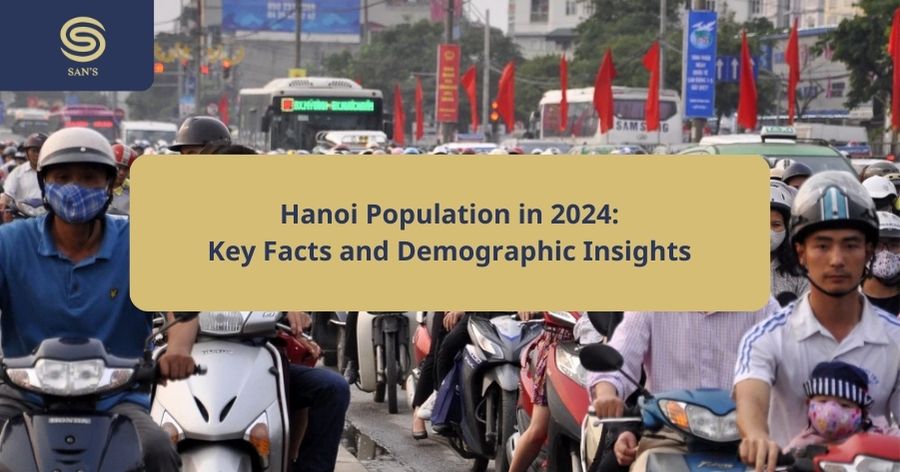Hanoi is the capital of Vietnam and a rapidly growing urban center. The Hanoi population serves as an indicator of the city’s economic and social development. The following article by San will provide a detailed analysis of Hanoi’s population in 2024, including key aspects such as overall population, growth rate, age and gender distribution, and the difference between urban and rural populations.
The Hanoi population overview in 2024
With nearly 8.5 million people, Hanoi’s population currently accounts for about 8.5% of the country’s population. However, Hanoi is only the second most populous city in Vietnam, after Ho Chi Minh City (with 8.9 million people).
Total population in Hanoi in 2024
According to the latest estimates, the total population of Hanoi in 2024 is projected to reach approximately 8.5 million people. This figure represents a steady increase from previous years, indicating a consistent growth pattern driven by both natural population growth and inward migration. When compared to the population figures of 2020, which stood at around 8 million, it’s clear that Hanoi’s growth trajectory remains robust.
This increase in population can be attributed to several factors, including improved economic conditions, expanded employment opportunities, and ongoing urban development projects that attract people from other provinces and cities to relocate to the capital.

Population growth rate
The Hanoi population growth rate has been consistently high over the past decade. The annual growth rate for the city is currently estimated at around 1.5%, which is significantly higher than the national average of 0,84%. Several factors contribute to this high growth rate, including the city’s strong economic performance, urbanization trends, and an influx of people seeking better job prospects and living conditions.
In 2023, Hanoi’s sex ratio at birth will decrease but remain high at 111.2 boys/100 girls, while the natural ratio is about 105/100. Due to the influence of Asian culture, which favors boys over girls, values the role of men as the pillars of the family, etc., the preference and desire to have sons to “have something to rely on in old age”; “continue the family line”… has been deeply ingrained in the minds of many Vietnamese people. The preference for sons is the root cause of the gender imbalance at birth in Vietnam.

Along with that, the desire to have a son in every family along with scientific and technological advances in obstetrics. Many families have abused these advances to carry out prenatal sex selection.
Population density in Hanoi
Hanoi is one of the most densely populated cities in Vietnam, with an average population density of approximately 2,400 people per square kilometer. However, the density varies significantly between different districts. For example, districts like Hoan Kiem, Ba Dinh, and Dong Da have much higher population densities due to their central locations and economic importance.
Demographic Breakdown of Hanoi’s Population
Age distribution
Hanoi’s population is relatively young, with a large proportion of residents falling within the working-age group (15-64 years old). Approximately 70% of the population is of working age, while 20% are children (under 15 years old), and the remaining 10% are elderly (65 years and older).
This age structure provides Hanoi with a strong labor force, which is a key driver of its economic growth. However, the city also faces challenges in terms of providing adequate social services and infrastructure for its growing elderly population, which is expected to increase in the coming decades.
Gender distribution
Vietnam’s average population in 2023 will reach 100.3 million people, with a fairly balanced male and female population ratio (49.9% for men and 50.1% for women).
However, certain districts may have slightly skewed gender ratios due to factors such as the presence of large industrial zones or educational institutions, which tend to attract more male or female workers and students, respectively.

Urban vs. Rural Population
Hanoi’s population is divided between urban and rural areas, with urban residents making up approximately 49.2% of the total population and rural residents accounting for the remaining 50.8%. The urban population is concentrated in central districts such as Hoan Kiem, Ba Dinh, and Hai Ba Trung, while the rural population is spread across the outer districts like Soc Son, Ba Vi, and Me Linh.
Urbanization is a major trend in Hanoi, with many rural areas gradually transforming into suburban neighborhoods as infrastructure and housing developments expand outward from the city center.
Key challenges for Hanoi’s population growth
As Hanoi’s population continues to grow, the city faces several challenges related to overpopulation in its urban districts. Traffic congestion, environmental pollution, and pressure on public services are all issues that need to be addressed to ensure sustainable development.
Meeting the housing needs of a growing population is a top priority for Hanoi. The city has implemented numerous housing projects and urban development plans to provide affordable housing options for its residents. However, ensuring adequate living conditions and avoiding overcrowding remain significant challenges.
The rapid increase in population has put pressure on Hanoi’s social services, including healthcare, education, and social welfare programs. The city is actively working to expand and improve these services to meet the needs of its residents, but more efforts are needed to ensure quality and accessibility.
Future Population Trends and projections for Hanoi
Based on current trends, Hanoi population is expected to reach 9 million by 2030. This growth will be driven by continued economic development, urbanization, and migration from other provinces.
Policy changes, such as new urban planning regulations and housing development projects, will play a significant role in shaping the Hanoi population growth and distribution in the coming years. These policies aim to promote balanced development and address issues related to overpopulation and infrastructure demands.

=> See more: Hanoi Time Zone Explained: Current Local Time and Time Difference
The Hanoi population in 2024 reflects its status as a dynamic and rapidly growing capital city. With a population of 8.5 million and a high growth rate, Hanoi is poised for continued expansion in the coming years. Understanding the demographic trends and challenges of the Hanoi population is essential for planning its future development and ensuring sustainable growth for the city and its residents.
Here are the “Hanoi Population in 2024” Wishing you a delightful trip to Asian! If you visit Vietnam and the capital Hanoi, you can book a room at San Hotel for the best prices here!
Follow us on Facebook to update the latest travel information daily: San Hotel Series





